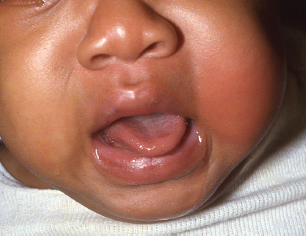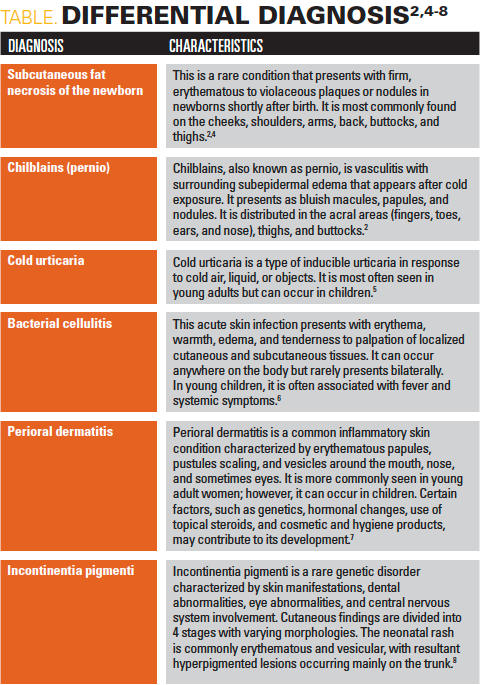Girl, 8 months, presents with red, painful cheeks
A healthy 8-month-old girl awoke with painful indurated red plaques on both cheeks, with the left worse than the right. Her mother said the girl had been sucking on a popsicle for 10 minutes the previous evening before bed. What's the diagnosis?
The case
A healthy 8-month-old girl awoke with painful indurated red plaques on both cheeks, with the left worse than the right. Although there was concern for cellulitis, she did not have a fever or other systemic symptoms. Her mother said the girl had been sucking on a popsicle for 10 minutes the previous evening before bed.

What's the diagnosis?
Popsicle-induced cold panniculitis (popsicle panniculitis)
Epidemiology and etiology
Cold panniculitis is a form of traumatic panniculitis that results from cold exposure. Resultant lesions can be generalized or localized, and they are seen after exposure to popsicles, ice packs, or cold weather.1,2 Cold-induced panniculitis from popsicles, also known as popsicle panniculitis, is a specific subtype of cold-induced panniculitis presenting as cheek plaques that occur due to prolonged exposure to cold temperatures from popsicles or ice cubes. Although relatively rare, popsicle panniculitis has been documented in medical literature, primarily in infants and children younger than 1 year.
The pathogenesis of popsicle panniculitis is unique to infants and children. Popsicle panniculitis occurs due to inflammation and damage to the subcutaneous fat tissue following exposure to cold temperatures. When these low temperatures are reached after popsicle exposure, freezing and subsequent fat liquefaction elicit an inflammatory process.1,3,4
Differential diagnosis
Although the diagnosis of popsicle panniculitis is clinical, based primarily on a history of cold exposure in an otherwise healthy child, the differential diagnoses include other panniculitides; cold-induced
dermatoses, including pernio and cold urticaria; bacterial cellulitis; perioral dermatitis; and incontinentia pigmenti (Bloch-Sulzberger syndrome) (Table).2,4-8
Table. Differential Diagnosis

Evaluation and workup
A detailed medical history is essential to evaluate the patient’s symptoms, including the onset and duration of symptoms with temporal relation to exposure to cold temperatures. Key physical exam features include the presence of tender nodules or plaques, erythema, induration, and discoloration of the affected skin. Popsicle panniculitis can manifest as reddish discoloration of bilateral cheeks with ill-defined margins and plaques and nodules on palpation. Red lesions will typically turn purple, become less indurated, and self-resolve within 2 to 3 weeks. The distribution and location of the lesions can provide clues to the diagnosis.2
Popsicle panniculitis is a clinical diagnosis and does not require additional diagnostic studies. Early and appropriate recognition can avoid unnecessary investigations. However, if there is concern for underlying systemic conditions or alternative diagnoses cannot be ruled out, laboratory work and histopathologic examination of a biopsy specimen may be indicated. Characteristic biopsy features reveal lobular panniculitis with an inflammatory infiltrate.4,9
Clinical course
Popsicle panniculitis typically follows a benign, self-limiting clinical course. Transient erythema is usually noted within 15 to 20 minutes after cold exposure, red plaques and nodules appear within 1-2 days, and lesions usually heal within 2 to 3 weeks. Postinflammatory hyperpigmentation may occur, especially in children with dark-pigmented skin.2 Our patient appeared well, and lesions resolved without treatment
2 weeks later.
Management and follow-up
Treatment is not typically indicated for popsicle panniculitis. Prolonged exposure to popsicles, ice, or other cold temperatures should be avoided. Heated pads have been shown to be partially successful in healing lesions; however, vasodilating drugs have not been shown to
be successful.2,4,9
References
1. Bolotin D, Duffy KL, Petronic-Rosic V, Rhee CJ, Myers PJ, Stein SL. Cold panniculitis following ice therapy for cardiac arrhythmia. Pediatr Dermatol. 2011;28(2):192-194. doi:10.1111/j.1525-1470.2010.01230.x
2. Quesada-Cortés A, Campos-Muñoz L, Díaz-Díaz RM, Casado-Jiménez M. Cold panniculitis. Dermatol Clin. 2008;26(4):485-489; vii. doi:10.1016/j.det.2008.05.015
3. Markus JR, de Carvalho VO, Abagge KT, Percicotte L. Ice age: a case of cold panniculitis. Arch Dis Child Fetal Neonatal Ed. 2011;96(3):F200. doi:10.1136/adc.2010.204412
4. Polcari IC, Stein SL. Panniculitis in childhood. Dermatol Ther. 2010;23(4):356-367. doi:10.1111/j.1529-8019.2010.01336.x
5. Prosty C, Gabrielli S, Mule P, et al. Cold urticaria in a pediatric cohort: clinical characteristics, management, and natural history. Pediatr Allergy Immunol. 2022;33(3):e13751. doi:10.1111/pai.13751
6. Brown BD, Hood Watson KL. Cellulitis. In: StatPearls. StatPearls Publishing; 2023.
7. Tolaymat L, Hall MR. Perioral Dermatitis. In: StatPearls. StatPearls Publishing; 2023.
8. Yadlapati S, Tripathy K. Incontinentia pigmenti (Bloch-Sulzberger Syndrome). In: StatPearls. StatPearls Publishing; 2023.
9. Requena L, Sánchez Yus E. Panniculitis. Part II. Mostly lobular panniculitis. J Am Acad Dermatol. 2001;45(3):325-364. doi:10.1067/mjd.2001.114735
Newsletter
Access practical, evidence-based guidance to support better care for our youngest patients. Join our email list for the latest clinical updates.
